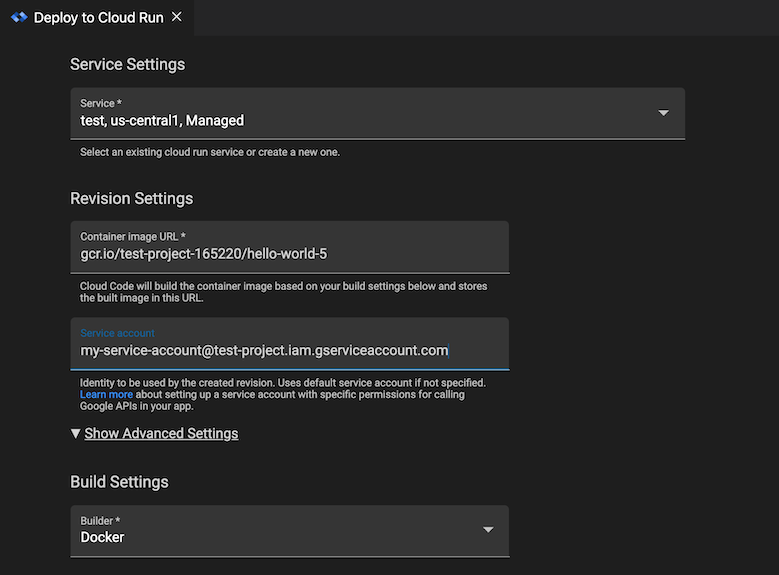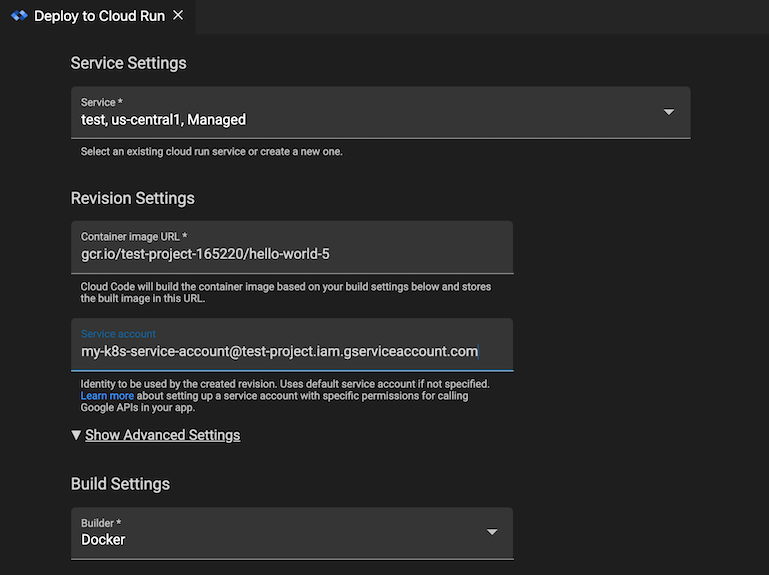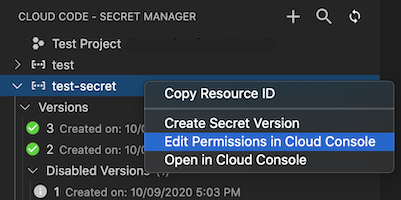To access Google Cloud products and services programmatically, you use Cloud APIs. These APIs expose a simple JSON REST interface. The recommended way to access the Cloud APIs is to use the Cloud Client Libraries.
Cloud Code makes it easy to add the Cloud Client Libraries for the Cloud APIs and language you're using to your project. In the same view, you can search for samples for each API and easily incorporate samples into your application.
Browsing Cloud APIs
To explore all available Google Cloud APIs:
Click
Cloud Code and then expand the Cloud APIs section.
The Cloud APIs view groups Cloud APIs by category.
To view details of an API, click the API name. Details such as the service name, status, installation instructions for client libraries, documentation, and code samples are displayed.
Enabling Cloud APIs
To enable Cloud APIs for a project using the API details page, follow these steps:
- On the Cloud API details page, choose the project to enable the Cloud API for.
- Click Enable API. After the API is enabled, a message is displayed to confirm the change.
Adding client libraries to your project
In addition to exploring and enabling Cloud APIs using Cloud Code, you can add a language-specific client library to your project.
To install a client library, follow the instructions on the API details page for your language.
Using API samples
You can search for and use code samples for each API in the API browser.
Click
Cloud Code and then expand the Cloud APIs section.
To open the detail view, click the name of an API.
To view code samples for the API, click Code Samples.
To filter the list of samples, type text to search for or choose a programming language from the Language list.
To view a sample, click the name of the sample. There are also options to copy the sample to your clipboard or view the sample in GitHub.
Setting up authentication
After you've enabled the required APIs and added the necessary client libraries, you need to configure your application for it to be successfully authenticated. Your configuration depends on your type of development and the platform you're running on.
After you complete the authentication steps, your application can authenticate and is ready to be deployed.
Local development
The Cloud Shell VM instance uses the Compute Engine default service account (the service account Google Kubernetes Engine uses by default) as its default service account. This means that when developing with Cloud Code on Cloud Shell, you don't need to set up any additional configuration when working with client libraries. Your application is authenticated and ready to run locally.
Local development with APIs that require a service account
Some APIs, such as the Cloud Translation API, require a service account with appropriate permissions to authenticate your requests. For more information, see Creating and managing service accounts.
To open a terminal, click Terminal > New Terminal.
Create a service account to authenticate your API requests:
gcloud iam service-accounts create \ SERVICE_ACCOUNT_ID \ --project PROJECT_ID
Replace the following values:
SERVICE_ACCOUNT_ID: the service account IDPROJECT_ID: the project ID
To find these IDs, in Google Cloud, click the Navigation menu at the top-left of the screen, hold your pointer over IAM & Admin and click Service Accounts.
The Email column shows the unique
SERVICE_ACCOUNT_IDandPROJECT_IDfor each of your service accounts in the following format:SERVICE_ACCOUNT_ID@PROJECT_ID.iam.gserviceaccount.comFor example: A service account email address of
my-service-account@my-project.iam.gserviceaccount.comhas the following values:SERVICE_ACCOUNT_ID:my-service-accountPROJECT_ID:my-project
Grant your service account the appropriate role. The following sample command grants the Cloud Translation API User role. To determine the role to grant, see the documentation for the Cloud API you're using.
gcloud projects \ add-iam-policy-binding \ PROJECT_ID \ --member='serviceAccount:SERVICE_ACCOUNT_ID@PROJECT_ID.iam.gserviceaccount.com' \ --role='roles/cloudtranslate.user'
Create a service account key:
gcloud iam service-accounts keys \ create key.json --iam-account \ SERVICE_ACCOUNT_ID@PROJECT_ID.iam.gserviceaccount.com
Set the key as your default credentials:
export \ GOOGLE_APPLICATION_CREDENTIALS=key.jsonOptional: To permit users to impersonate the service account, run the
gcloud iam service-accounts add-iam-policy-bindingcommand to grant a user the Service Account User role (roles/iam.serviceAccountUser) on the service account:gcloud iam service-accounts add-iam-policy-binding \ SERVICE_ACCOUNT_ID@PROJECT_ID.iam.gserviceaccount.com \ --member="user:USER_EMAIL" \ --role="roles/iam.serviceAccountUser"
Replace the following values:
USER_EMAIL: the email address for the user
Remote development
GKE
Depending on the scope of your project, you can choose how you authenticate Google Cloud services on GKE:
- (Development only)
- Create a GKE cluster with the following settings:
- Make sure that you're using the service account GKE uses by default, the Compute Engine default service account, and that Access scopes is set at Allow full access to all Cloud APIs (both settings are accessible in the Node Pools > Security section). Since the Compute Engine service account is shared by all workloads deployed on your node, this method overprovisions permissions and should only be used for development.
- Make sure that Workload Identity isn't enabled on your cluster (in the Cluster > Security section).
- Assign the necessary roles to your service account:
- If you're using the Compute Engine default service account, the correct IAM roles might already be applied.
- For a list of IAM role types and predefined roles that you can grant to identities, see the Understanding roles guide. For steps to grant the roles, see Granting, changing, and revoking access to resources.
- Create a GKE cluster with the following settings:
- (Recommended for production)
- Configure your GKE cluster and application with Workload Identity to authenticate Google Cloud services on GKE. This associates your Kubernetes service account with your Google service account.
- Configure your Kubernetes Deployment to reference the Kubernetes service
account by setting the
.spec.serviceAccountNamefield in your Kubernetes Deployment YAML file. If you're working on an app created from a Cloud Code sample application, this file is located under the kubernetes-manifests folder. - If the Google Cloud service you're trying to access
requires additional roles, grant them for the Google service
account you're using to develop your app:
- For a list of IAM role types and predefined roles you can grant to identities, see the Understanding roles guide. For steps to grant the roles, see Granting, changing, and revoking access to resources.
Cloud Run
- To create a new unique service account for deploying your Cloud Run application, navigate to the Service Accounts page and then select the project that your secret is stored in.
- Click Create service account.
- In the Create service account dialog, enter a descriptive name for the service account.
- Change the Service account ID to a unique, recognizable value and then click Create.
- If the Google Cloud service you're trying to access requires additional roles, grant the roles, click Continue, and then click Done.
- To add your service account to your deploy configuration:
- Using the Cloud Code status bar, choose the Cloud Run: Deploy command.
- In the Cloud Run Deployment UI, under Revision Settings, in the Service Account field, specify your service account.

Cloud Run
Depending on the scope of your project, you can choose how you authenticate Google Cloud services on GKE:
- (Development only)
- Create a GKE cluster
with the following settings:
- Make sure that you're using the service account that GKE uses by default, the Compute Engine default service account, and that Access scopes is set at Allow full access to all Cloud APIs (both settings accessible in the Node Pools > Security section). Since the Compute Engine service account is shared by all workloads deployed on your node, this method overprovisions permissions and should only be used for development.
- Make sure that Workload Identity isn't enabled on your cluster (in the Cluster > Security section).
- Assign the necessary roles to your service account:
- If you're using the Compute Engine default service account, the correct IAM roles might already be applied.
- For a list of IAM role types and predefined roles you can grant to identities, see the Understanding roles guide. For steps to grant the roles, see Granting, changing, and revoking access to resources.
- Create a GKE cluster
with the following settings:
- (Recommended for production)
- Configure your GKE cluster and application with Workload Identity to authenticate Google Cloud services on GKE. This associates your Kubernetes service account with your Google service account.
- To add your service account to your deploy configuration:
- Using the Cloud Code status bar, choose the Cloud Run: Deploy command.
- In the Cloud Run Deployment UI, under Revision Settings, in the Service Account field, specify your service account.

- If the Google Cloud service you're trying to access requires additional
roles, grant them for the Google service account you're using to develop
your app:
- For a list of IAM role types and predefined roles you can grant to identities, see the Understanding roles guide. For steps to grant the roles, see Granting, changing, and revoking access to resources.
Remote development with Secret Manager permissions enabled
If you're developing remotely, using a service account for authentication, and your application uses secrets, you need to complete a few more steps in addition to the remote development instructions. These steps assign your Google service account the role required to access a particular Secret Manager secret:
Click
Cloud Code and then expand the Secret Manager section.

Right-click the secret and select Edit Permissions in Cloud console. This launches the Secret Manager configuration page for that secret in your web browser.

In Google Cloud console, click Permissions and then click Add.
In the New principals field, enter the name of your service account.
In the Select a role field, choose the Secret Manager Secret Accessor role.
Click Save.
Your service account now has permission to access this particular secret.
